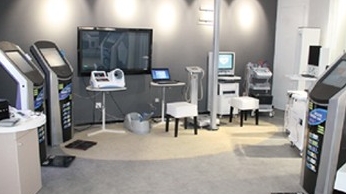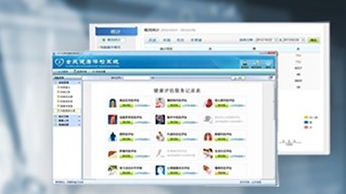分類導(dǎo)航
推薦新聞
聯(lián)系我們
 濟(jì)南易享醫(yī)療科技有限公司
濟(jì)南易享醫(yī)療科技有限公司
服務(wù)熱線:18553158035
聯(lián)系地址:濟(jì)南市高新區(qū)新濼大街1666號(hào)齊盛廣場2號(hào)樓15樓
如何使用隨訪一體機(jī)為患者提供持續(xù)的健康指導(dǎo)和支持
使用隨訪一體機(jī)為患者提供持續(xù)的健康指導(dǎo)和支持是一個(gè)細(xì)致且高效的過程,涉及多個(gè)方面和環(huán)節(jié)。以下是根據(jù)高權(quán)威性來源整理的具體方法和建議:
Providing patients with continuous health guidance and support using a follow-up all-in-one machine is a meticulous and efficient process, involving multiple aspects and links. The following are specific methods and suggestions collated from highly authoritative sources:

一、準(zhǔn)備階段
1. Preparation stage
1、確保隨訪包設(shè)備完好:
1. Ensure that the follow-up package equipment is in good condition:
檢查隨訪包內(nèi)的醫(yī)療設(shè)備(如血壓計(jì)、血糖儀、心電圖儀等)功能是否完好,電池電量是否充足。
Check whether the medical equipment (such as sphygmomanometers, blood glucose meters, electrocardiographs, etc.) in the follow-up package are functioning properly and whether the batteries are fully charged.
確保通訊設(shè)備(如手機(jī)、平板電腦)網(wǎng)絡(luò)連接穩(wěn)定,便于數(shù)據(jù)傳輸和遠(yuǎn)程溝通。
Ensure stable network connections for communication devices (such as mobile phones and tablet computers) to facilitate data transmission and remote communication.
2、整理患者資料:
2. Organize patient information:
提前整理好需要隨訪的慢性病患者的個(gè)人信息、病史資料及之前的檢查記錄。
Prepare the personal information, medical history, and previous examination records of chronic disease patients who need follow-up visits in advance.
確保患者聯(lián)系方式的準(zhǔn)確性,以便在需要時(shí)及時(shí)聯(lián)系。
Ensure the accuracy of patients' contact information, so as to contact them promptly when necessary.
3、制定隨訪計(jì)劃:
3. Develop a follow-up plan:
根據(jù)患者的病情和需求,制定個(gè)性化的隨訪計(jì)劃。
Develop a personalized follow-up plan based on the patient's condition and needs.
確定隨訪的頻率、內(nèi)容和方式,確保患者得到持續(xù)的關(guān)注和照顧。
Determine the frequency, content, and method of follow-up visits to ensure that patients receive continuous attention and care.
二、隨訪與健康檢查
II. Follow-up and Health Examination
1、進(jìn)行健康檢查:
1. Conduct a health check-up:
攜帶隨訪包前往患者家中或約定地點(diǎn)進(jìn)行隨訪。
Take the follow-up package to the patient's home or the agreed location for follow-up.
使用隨訪包內(nèi)的醫(yī)療設(shè)備對患者進(jìn)行健康檢查,包括血壓、血糖、心率等生理指標(biāo)的測量。
Use the medical equipment in the follow-up package to conduct health checks on patients, including measurements of physiological indicators such as blood pressure, blood glucose, and heart rate.
2、記錄與評估:
2. Recording and evaluation:
將現(xiàn)場測量的數(shù)據(jù)及時(shí)記錄,并上傳至健康管理平臺(tái)或患者的健康管理系統(tǒng)。
Record the on-site measured data in a timely manner and upload it to the health management platform or the patient's health management system.
利用健康管理平臺(tái)或?qū)I(yè)數(shù)據(jù)分析軟件,對患者的健康數(shù)據(jù)進(jìn)行分析和評估。
Utilize health management platforms or professional data analysis software to analyze and evaluate patients' health data.
三、提供健康指導(dǎo)
III. Provide health guidance
1、個(gè)性化飲食指導(dǎo):
1. Personalized dietary guidance:
根據(jù)患者的具體病情和營養(yǎng)需求,提供個(gè)性化的飲食建議。
Provide personalized dietary advice based on the patient's specific condition and nutritional needs.
如高血壓患者要減少鈉鹽攝入,增加鉀攝入;糖尿病患者需控制碳水化合物攝入量,選擇低升糖指數(shù)的食物。
For example, patients with hypertension should reduce their sodium intake and increase their potassium intake; patients with diabetes need to control their carbohydrate intake and choose foods with a low glycemic index.
2、運(yùn)動(dòng)與生活方式建議:
2. Suggestions on exercise and lifestyle:
根據(jù)患者的身體狀況和運(yùn)動(dòng)能力,制定合適的運(yùn)動(dòng)計(jì)劃。
Develop an appropriate exercise plan based on the patient's physical condition and exercise capacity.
鼓勵(lì)患者保持規(guī)律的作息,戒煙限酒,保持良好的生活習(xí)慣。
Encourage patients to maintain a regular daily routine, quit smoking and limit alcohol consumption, and uphold good living habits.
3、用藥指導(dǎo):
3. Medication guidance:
詳細(xì)解釋患者所用藥物的作用、用法、用量及可能出現(xiàn)的副作用。
Elaborate on the effects, usage, dosage, and potential side effects of the medications prescribed to the patient.
強(qiáng)調(diào)按時(shí)、按量服藥的重要性,避免自行增減劑量或停藥。
Emphasize the importance of taking medication on time and in the prescribed dosage, and avoid increasing or decreasing the dosage or discontinuing medication on one's own.
四、心理支持與教育
IV. Psychological support and education
1、心理評估與支持:
1. Psychological assessment and support:
使用簡單的心理評估工具,如焦慮、抑郁自評量表,對患者的心理狀態(tài)進(jìn)行初步評估。
Utilize straightforward psychological assessment tools, such as self-rating anxiety scales and self-rating depression scales, to conduct a preliminary evaluation of the patient's psychological state.
根據(jù)患者的心理狀態(tài)和需求,提供個(gè)性化的心理支持,如鼓勵(lì)、安慰、解釋等。
Based on the patient's psychological state and needs, provide personalized psychological support, such as encouragement, comfort, explanation, etc.
2、健康教育:
2. Health education:
向患者普及慢性病的相關(guān)知識(shí),包括病因、癥狀、治療方法及預(yù)防措施等。
Educate patients on chronic diseases, including their causes, symptoms, treatment methods, and preventive measures.
發(fā)放健康教育資料,如宣傳手冊、視頻等,方便患者隨時(shí)學(xué)習(xí)和參考。
Distribute health education materials, such as brochures and videos, to facilitate patients' learning and reference at any time.
五、持續(xù)跟進(jìn)與調(diào)整
V. Continuous follow-up and adjustment
1、定期隨訪:
1. Regular follow-up visits:
按照隨訪計(jì)劃,定期對患者進(jìn)行隨訪,了解病情變化。
According to the follow-up plan, patients are regularly visited to understand changes in their condition.
在隨訪過程中,再次強(qiáng)調(diào)健康指導(dǎo)和支持的重要性,并根據(jù)患者的實(shí)際情況進(jìn)行調(diào)整。
During the follow-up process, the importance of health guidance and support is emphasized again, and adjustments are made according to the actual situation of the patients.
2、調(diào)整治療方案:
2. Adjust treatment plan:
根據(jù)患者的隨訪結(jié)果和病情變化,及時(shí)調(diào)整治療方案。
Adjust the treatment plan in a timely manner based on the patient's follow-up results and changes in their condition.
確保患者得到最適合自己的治療和管理,提高治療效果和生活質(zhì)量。
Ensure that patients receive the most suitable treatment and management for themselves, thereby improving treatment outcomes and quality of life.
3、建立長期關(guān)系:
3. Establish long-term relationships:
與患者建立長期的隨訪關(guān)系,定期了解他們的心理狀態(tài)和健康狀況。
Establish a long-term follow-up relationship with patients, regularly understanding their psychological state and health condition.
鼓勵(lì)患者在遇到問題時(shí)及時(shí)聯(lián)系醫(yī)療團(tuán)隊(duì),尋求幫助和支持。
Encourage patients to promptly contact the medical team for assistance and support when encountering problems.
通過以上措施的實(shí)施,隨訪一體機(jī)可以有效地為患者提供持續(xù)的健康指導(dǎo)和支持,幫助他們更好地控制病情、預(yù)防并發(fā)癥、提高生活質(zhì)量。同時(shí),也增強(qiáng)了患者與醫(yī)療團(tuán)隊(duì)之間的信任和溝通,為慢性病的防治工作奠定了堅(jiān)實(shí)的基礎(chǔ)。
Through the implementation of the above measures, the follow-up all-in-one machine can effectively provide patients with continuous health guidance and support, helping them better control their condition, prevent complications, and improve their quality of life. At the same time, it also enhances the trust and communication between patients and the medical team, laying a solid foundation for the prevention and treatment of chronic diseases.
本文由 隨訪一體機(jī) 友情奉獻(xiàn).更多有關(guān)的知識(shí)請點(diǎn)擊 http://www.yywed.cn/ 真誠的態(tài)度.為您提供為全面的服務(wù).更多有關(guān)的知識(shí)我們將會(huì)陸續(xù)向大家奉獻(xiàn).敬請期待.
This article is kindly contributed by the Follow-up All-in-One Machine. For more relevant knowledge, please visit http://www.yywed.cn/ with a sincere attitude. We will provide you with comprehensive services. More relevant knowledge will be continuously contributed to you. Please stay tuned
上一條:公共隨訪箱塑造智能化生活新格局
相關(guān)文章 / Recommended news
- 如何使用隨訪一體機(jī)為患者提供持續(xù)的健康指導(dǎo)和支持
- 公共隨訪箱塑造智能化生活新格局
- 基層體檢中利用公衛(wèi)隨訪包推進(jìn)社區(qū)“醫(yī)養(yǎng)結(jié)合” 體檢服務(wù)“零距離”
- 公衛(wèi)隨訪包的投入使用,為基層機(jī)構(gòu)插上數(shù)字化的翅膀
- 家簽隨訪包通常都有哪些設(shè)備部件?
- 健康小屋的開設(shè)對社區(qū)居民有哪些好處?
- 家簽工作站正通過“檢測-評估-干預(yù)-宣教”一體化服務(wù)模式成為守護(hù)群眾健康的“前沿哨所”
- 慢性包幫助患者健康管理自己身體情況
- 健康一體機(jī)依托互聯(lián)網(wǎng)醫(yī)療平臺(tái)實(shí)現(xiàn)“線下檢測+線上服務(wù)”
- 一般來說公衛(wèi)隨訪箱有哪些必要的醫(yī)療設(shè)備?




